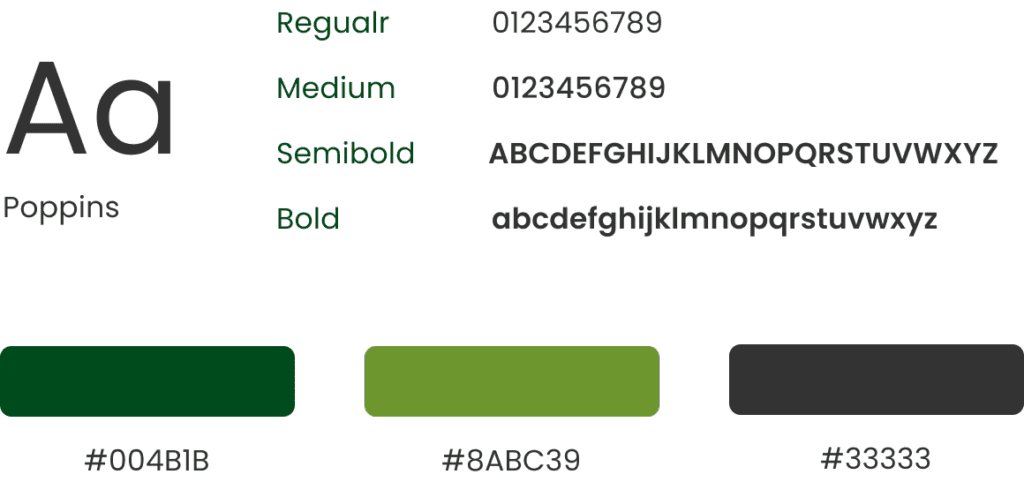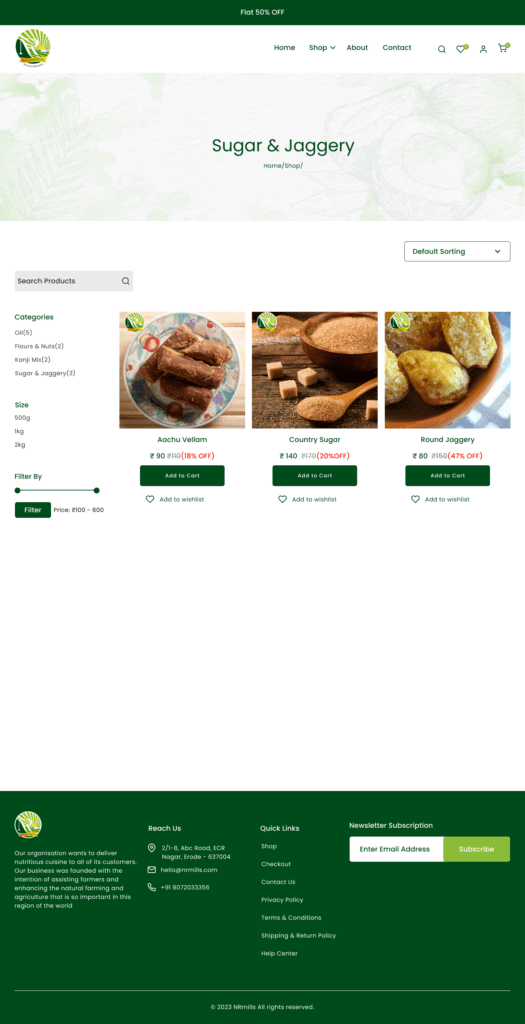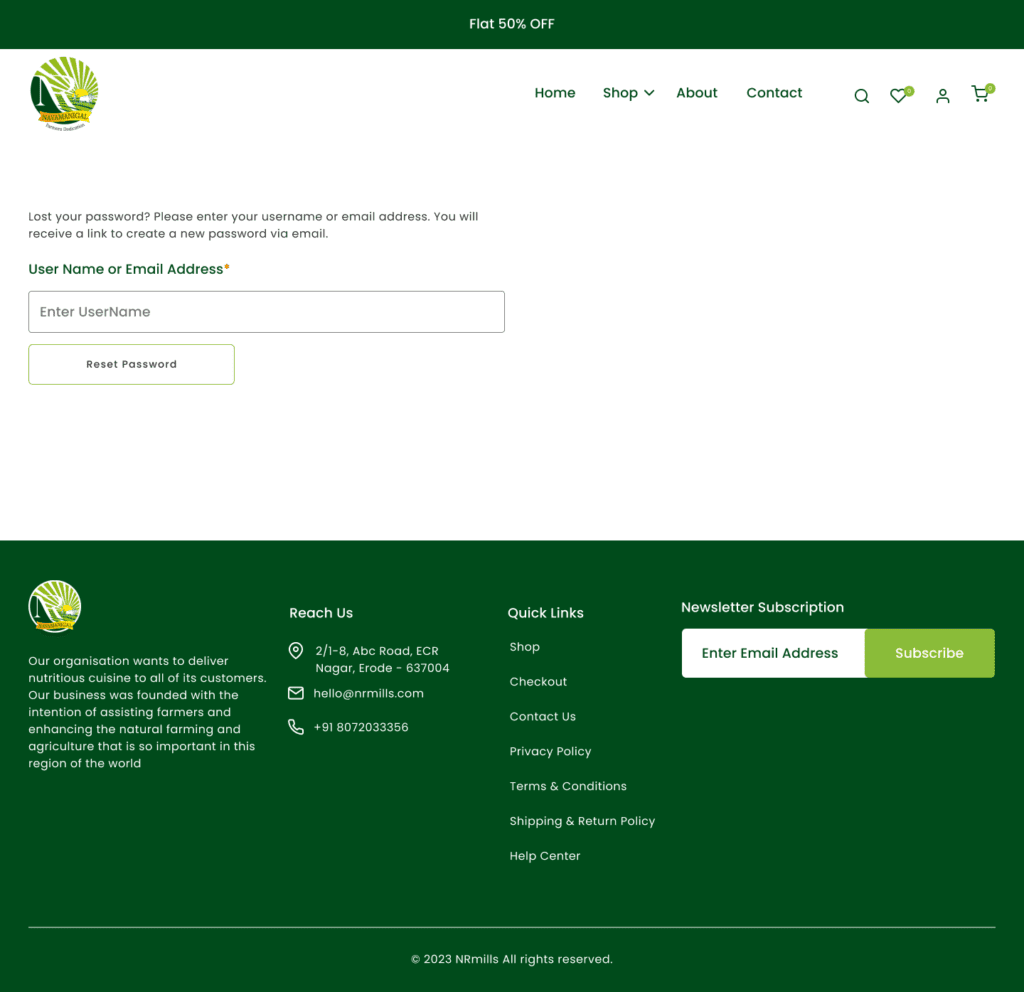NR Mills
Online Grocery Shopping

Project Overview
In the era of digital dominance, even time-honored traditions like shopping for oil are evolving. Our case study dives into the journey of a traditional oil retail brand as it embraces the digital age. The goal was to combine traditional local shopping with the convenience of online shopping.
Problem Statement
- Users who have long been familiar with the traditional in-store shopping experience for oil products often hesitate to shift to online purchases due to worries about authenticity, trustworthiness, and product quality.
- Additionally, the perceived inconvenience of high shipping rates and the absence of physical examination further discourage users from adopting online grocery shopping.


Solution
- Optimized checkout flow for a straightforward experience.
- Free shipping to enhance satisfaction and drive sales.
- Secure payment gateways to protect user transactions.
- Hassle-free guest checkout option.
- Multiple payment methods for user convenience.
- Dedicated customer support for assistance.
- Social proof (reviews and ratings) for product trustworthiness.
Design Process
Discover
Define
Ideate
Design
Market Analysis
Online Grocery Market in India:
The Indian online grocery market was valued at USD 2.9 billion in 2020 and is projected to grow at a CAGR of 37.1% from 2021 to 2028.
This growth is driven by changing consumer lifestyles, increasing urbanization, and a tech-savvy generation that prefers online shopping. Rising incomes and busy lifestyles are prompting people to opt for convenient online grocery platforms. The preference for online grocery shopping became more evident during the COVID-19 pandemic due to safety concerns and social distancing measures.

Secondary Research


e-commerce site can gain a 35.26% increase in conversion rate though better checkout design
Source from – Banyard.com
Data's Collected from secondary Research
lack of physical examination – No guarantee of the quality of the product and the lack of physical examination are two things that the customers see as a hindrance in the online grocery shopping platforms
Social proof – As physical examination and guarantee are the major hindrances consumers are facing while shopping online, online grocers should focus on Product reviews. In this way the consumers will have an idea about another consumer’s experience in using the product and if it will meet the standards of the consumer’s requirements
- Item, Order, and User-level Averages
The average number of items per order is around 5, indicating that consumers are looking for quick and easy ways to stock up on their daily essentials. - Furthermore, around 90% of consumers choose to pay online, showing their trust and confidence in the ecommerce platforms. And with an average discount of around 100 INR per order, consumers are finding ways to save even more on their grocery bills.
Qualitative Research
Conducted phone interviews with 10 potential users to learn about theirOil purchasing , usage and understand their thoughts and experiences.
1.What types of oil products do you typically use in your cooking or daily life?
2. How do you decide which specific brand or type of oil to purchase for different purposes?
3. Are there any specific factors that influence your decision when buying oil products? (e.g., price, brand reputation, health benefits, etc.)
4. Can you share any preferences or reasons behind choosing a particular type of oil for different cooking methods or dishes?
5. Have you ever tried different brands or varieties of oil? If so, what led you to try new ones, and how did you make your selection?
6. Are there any specific qualities or features you look for in oil products when making a purchase?
7. What role does oil play in your overall cooking and dietary habits?
8. How frequently do you purchase oil products for your cooking or daily needs?
9. Are there any specific occasions or events that influence your oil purchasing frequency?
10. Do you tend to buy oil products in bulk, or do you prefer to make smaller, more frequent purchases?
11. How do you plan your oil purchases? Do you prefer to stock up in advance, or do you buy as needed?
12. Are there any seasonal variations in your oil purchasing patterns?
13. Have you ever changed your oil purchasing frequency based on promotions or discounts offered by specific brands or stores?
14. Do you have any preferred sources or stores for purchasing oil?
15. Do you purchase oil online? If the answer is yes, what factors influence your online purchases? If the answer is no, please provide the reason.
Common Answers from the users
Coconut oil, gingelly oil, Groundnut oil, castor oil, Light Lamp oil
Most of the users used Idhayam Nallennai(gingelly oil) and Mr. Gold( Groundnut oil)
For most users, prioritising health benefits is of utmost importance.
Many users prefer to use gingelly oil for dishes like puli kulambu and fish curry, while they opt for groundnut oil for regular or normal dishes.
oil plays a major role for most of the users, because it enhances the taste of the dish.
During Diwali and Pongal, users’ oil purchasing frequency changes
Most of us purchase oil from the (Offline)store, and once they receive their salary, they plan to buy grocery items
Most of the users stock up on oil in advance
Few people said they consider discounts when new brands provide offers. Another few people mentioned that offers and discounts never affect their oil purchasing patterns.
User Persona
I created two completely different personas to understand the user journey from two separate backgrounds.


Empathy Map


Competitor Audit

SWOT Analysis

User Flow

Information Architecture

Style Guide

LOW - Fi Wireframe

Hi - Fi Wireframe
Home

Shop

About Us

Product Category




Single Product




Checkout Process




Add to Cart

Login / Register

Forget Password

Contact Us

Thank You

Mobile mockup







Video Prototype
Anticipated Business Metrics
Anticipated Business Metrics: While the oil project website is in the planning phase and not yet operational, our design thinking approach has identified several potential benefits for the business once it goes live. These anticipated business metrics include
- Improved Conversion Rates: By optimizing the checkout flow, we aim to reduce cart abandonment rates, leading to an increase in completed purchases and revenue generation.
- Enhanced Customer Loyalty: The introduction of free shipping is expected to enhance customer satisfaction, potentially increasing customer loyalty and repeat purchases.
- Trust and Security: Secure payment gateways will build trust with users, potentially leading to higher transaction volumes and a reduction in fraud-related issues.
- Expanded Customer Base: Offering hassle-free guest checkout and multiple payment methods can attract a broader audience, increasing the potential customer base.
- Improved Customer Satisfaction: The presence of dedicated customer support is anticipated to improve overall customer satisfaction, contributing to positive word-of-mouth referrals and trust in the brand.
- Influence on Purchase Decisions: Social proof in the form of reviews and ratings is expected to positively influence users’ purchase decisions, potentially boosting sales.
